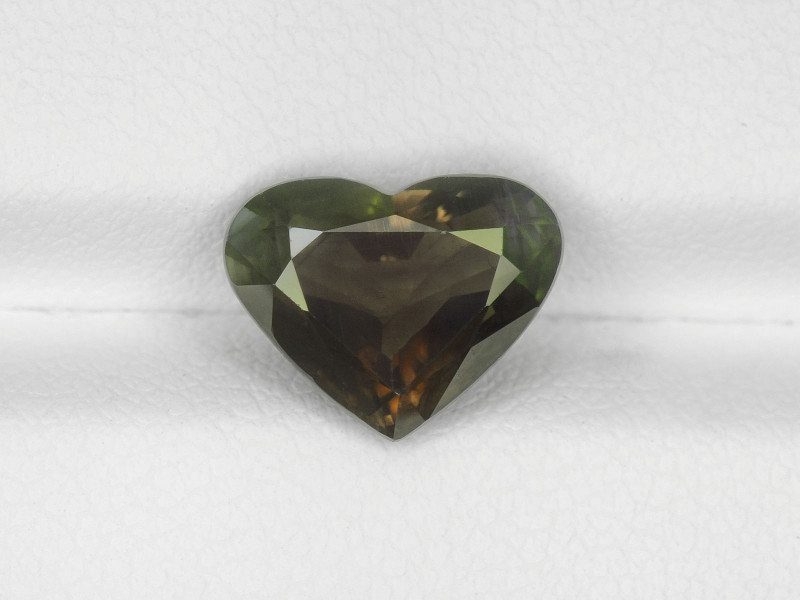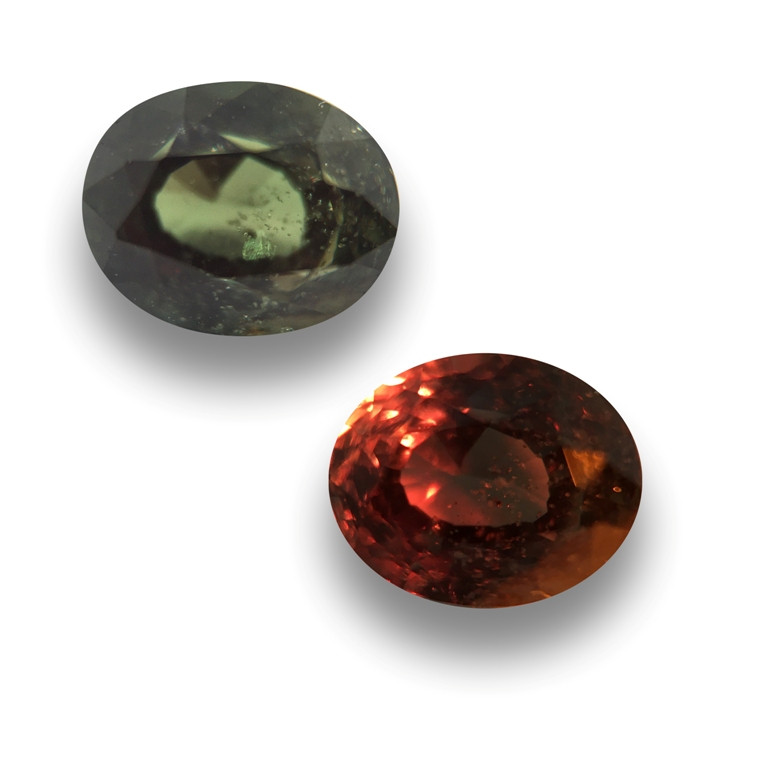
紫翠玉:含义、历史、特性和价值
紫翠玉是一种金绿玉,以其稀有性和令人着迷的变色特性而闻名。如果您小时候喜欢变色的心情戒指,那么紫翠玉绝对是您打造的高档精致成人戒指的完美之选。
亚历山大变石原产于俄罗斯,但受到世界各地宝石爱好者和珠宝商的喜爱。
亚历山大变石的绰号之一是“白天的祖母绿,晚上的红宝石”。亚历山大变石的色彩会将您带入一个充满闪耀绿光和红色的温馨假日派对。而这颗宝石的美丽定会让您全年都为之着迷。
想了解更多?来对地方了!我们凭借多年的经验和专业知识,为您带来这份全面的亚历山大变石指南,涵盖其历史、地质、特性,以及其能量、意义和价格。

关于紫翠玉
紫翠玉是一种非常稀有的半宝石,其最出名的颜色是在日光下从翠绿色变为白炽灯下的红宝石红色。
但亚历山大变石究竟有多稀有呢?它被认为是最稀有的宝石之一!尽管是半宝石,但亚历山大变石比四大宝石(钻石、蓝宝石、祖母绿和红宝石)更为稀有。
对于我们那些出生在夏季的优雅读者来说,亚历山大变石与珍珠和月光石并列为六月诞生石。这种宝石的双重特性也使其作为双子座诞生石的益处相得益彰。
活动策划师可能也知道六月是婚礼旺季。如果您在六月举办婚礼,那么亚历山大变石作为传统的55周年结婚纪念宝石,将格外特别,是送给爱人的完美纪念礼物。

紫翠玉的规格和特征
作为金绿玉的一个变种,亚历山大变石的化学式与金绿玉相同:BeAl2O4。然而,亚历山大变石之所以具有独特的特性(即其变色特性),是因为部分铝元素被铬元素取代——有些样品的铬含量低于 1%,但仍然是亚历山大变石!
由于铬的重要性,一些宝石学家将亚历山大变石的化学式写为BeAl2O4 + Cr。
事实上,“亚历山大变石”并非国际矿物学协会 (IMA) 认可的正式矿物名称,而通常被认为是一种铬金绿玉的营销术语。
就晶体习性而言,亚历山大变石晶体可能呈长条形或短板形。许多金绿玉晶体,例如亚历山大变石,都具有明显的条纹。此外,接触孪生和穿透孪生在金绿玉晶体中很常见;这些孪生晶体甚至可以形成玫瑰花结。
想知道如何鉴别亚历山大变石吗?最简单的方法是观察颜色变化。
紫翠玉在阳光下会呈现绿色或蓝绿色,在白炽灯下则会呈现红色、橙黄色或洋红色。紫翠玉是少数能够变色的宝石之一,也是最受欢迎的宝石之一,宝石的变色通常被称为“紫翠玉效应”。
以下列出了亚历山大变石的矿物特性:
莫氏硬度:8.5
颜色:因光源而异;日光或荧光:绿色、蓝绿色、绿蓝色、黄绿色或蓝灰色;白炽灯或烛光:红色、覆盆子红色、红紫色、紫红色、淡紫色、紫罗兰色、灰紫色或棕红色
晶体结构:正交
光泽:玻璃质(玻璃状)
透明度:透明至不透明
折射率:1.745-1.759
密度:3.68-3.80
解理:{110} 清晰/良好至差
断口:贝壳状或不规则状
条痕:白色
发光:存在荧光 - 短波紫外和长波紫外光下呈现弱红色
多色性:存在且强烈;绿色、黄橙色(或橙色)和红色(或紫红色)
双折射率:0.008-0.010
分散度:0.015
光学效应:颜色变化;罕见的猫眼效应或星光效应
除了矿物学之外,亚历山大变石的起源和历史是什么?它主要分布在哪里?
 上图:博物馆展出的镶嵌有钻石和紫翠玉的金戒指 | 图片来源:史密森尼美国艺术博物馆藏品,公共领域
上图:博物馆展出的镶嵌有钻石和紫翠玉的金戒指 | 图片来源:史密森尼美国艺术博物馆藏品,公共领域
镶嵌钻石和紫翠玉的黄金
紫翠玉的历史
亚历山大变石的发现和命名背后充满争议。其起源故事发生在 俄罗斯,核心人物包括一位芬兰矿物学家、一位俄罗斯矿物学家和一位俄罗斯乌拉尔矿场经理。
先从名字说起吧。紫翠玉的名字毫无疑问得自俄国沙皇亚历山大二世。(听说过阿纳斯塔西娅·罗曼诺夫吗?亚历山大二世是她的曾祖父。)
1833年,这颗宝石在俄罗斯乌拉尔山脉——确切地说是叶卡捷琳堡附近的祖母绿矿区——被发现。当时,亚历山大二世还不是沙皇,但即将迎来16岁生日,正式成为皇太子(Tsesarevich ,即皇储)。紫翠玉与当时俄罗斯的两种军旗颜色相配,因此这个名字恰如其分。
当谈到谁首先发现并命名亚历山大变石时,事实就变得模糊不清了。
Nordenskiöld 和 Perovskii 的发现故事
有一则传说称,芬兰矿物学家尼尔斯·古斯塔夫·诺登斯基奥尔德(Nils Gustaf Nordenskiöld)在查看了乌拉尔矿的样本后,首次鉴定出了这块宝石。诺登斯基奥尔德从俄罗斯矿物学家列夫·阿列克谢维奇·佩罗夫斯基伯爵(Count Lev Alekseevich Perovskii)手中获得了这些样本。
诺登舍尔德起初以为那是祖母绿,但硬度太高。后来,他看到它在烛光下变成了覆盆子红色,意识到这是一种新的变色金绿玉品种(最早描述于1792年)。
鉴于这种颜色变化现象,诺登舍尔德提出了“透辉石”这一名称,该名称源自希腊语di (意为“二”)和aphanes (意为“看不见”)或phan (意为“出现”)。
佩罗夫斯基得知诺登舍尔德的发现后,据称于1834年4月17日(亚历山大16岁生日庆典期间)将这颗宝石赠予亚历山大二世,并赋予其新名字“亚历山大变石”。(一些历史学家认为,佩罗夫斯基这样做是为了讨好皇室,从而提升自己的地位。)
其他关于紫翠玉发现的理论
另一个可能的起源故事来自历史学家理查德·A·怀斯。怀斯声称,乌拉尔矿场经理兼叶卡捷琳堡宝石工场负责人雅科夫·科科温(有时写作科科温·雅科夫·瓦西里耶维奇)首先发现并鉴定了亚历山大变石。
佩罗夫斯基伯爵后来指控科科温盗窃皇家珠宝,尽管没有任何证据,导致科科温丢掉了职位并入狱。这项指控以及科科温随后在狱中自杀,或许导致了他从亚历山大变石的历史上消失。
有趣的是,更早的发现可能发生在德国。矿物学教授古斯塔夫·罗斯(Gustav Rose)在1829年撰写了一篇关于金绿玉的新文章,该文章与亚历山大变石相似。
尽管如此,大多数历史学家和宝石学家都同意,第一个有官方记录的亚历山大变石是在俄罗斯乌拉尔山脉发现的。
无论如何,这块宝石在全球引起了轰动,并在 1881 年沙皇遇刺、1917 年俄罗斯贵族统治最终终结之后很长一段时间内,仍然与俄罗斯和沙皇保持着联系。
除了其丰富的历史之外,亚历山大变石还具有什么形而上学的特性或信仰吗?
 上图:猫眼紫翠玉宝石戒指与点缀钻石并排摆放,分别在荧光灯(左)和人造光(右)下展示
上图:猫眼紫翠玉宝石戒指与点缀钻石并排摆放,分别在荧光灯(左)和人造光(右)下展示
紫翠玉的含义
亚历山大变石常被称为“变色龙石”,其象征意义与其色彩一样丰富多样。亚历山大变石通常象征着智慧和好运。然而,亚历山大变石表面的互补色赋予了它更深层的含义。
任何熟悉色彩理论基础知识的人都知道,红色和绿色在色轮上是相对的,或者说是“互补色”。除了相互衬托之外,这两种颜色各自的象征意义结合在一起,创造出了一对充满活力的组合。
红色的激情、活力和性感,似乎与平和、以增长为导向的绿色相悖。然而,拥抱光谱(或色轮)的两端,可以为生活的方方面面带来自发性和创新性。
在不同的文化中,亚历山大变石的精神意义是什么?
在俄罗斯,亚历山大变石象征着个人的骄傲和威望。它的精神意义被人们视为至高无上之物,据说沙皇亚历山大二世(亚历山大变石的由来)每天都会佩戴一枚亚历山大变石戒指作为护身符。
许多文化都声称,变石会变色以警告佩戴者危险。中国人认为变石与血液有关,认为这种宝石可以改善循环系统。受希腊人对紫水晶的看法的影响,印度教徒认为变石可以治疗醉酒。
说到治疗,亚历山大变石具有哪些治疗功效?

紫翠玉的治疗功效
鉴于亚历山大变石的双重特性,它的许多疗愈功效都与平衡有关也就不足为奇了。从精神层面来说,这种宝石可以帮助我们平衡身心健康。此外,亚历山大变石提醒我们,自然界万物都是协同运作的。
情绪疗愈
与许多 绿色宝石一样,亚历山大变石的疗愈功效包括帮助我们找到内心的平静,享受周围的世界。亚历山大变石让我们接受变化是生活的一部分,它能为我们的日常生活带来疗愈和正念。
身体康复
在身体健康方面,紫翠玉有助于调节循环系统,对全身健康有益。具体来说,紫翠玉常用于治疗炎症、痉挛和紧张等问题。
回到精神层面,亚历山大变石在脉轮治疗中有什么用途?
脉轮疗愈
作为脉轮石,亚历山大变石能够开启并平衡顶轮。顶轮是七个脉轮中最高的一个,它代表着我们从基本生理需求到最高精神自我的旅程。
顶轮阻塞,你可能会感到与世隔绝、灵感枯竭,漫无目的地漂泊,没有依靠。紫翠玉可以打开顶轮,为你的生活注入温暖的能量,为强大的精神蜕变奠定基础。
在开始使用紫翠玉进行治疗之前,您需要找到合适的紫翠玉。
那么,业内哪些因素影响着紫翠玉宝石的定价和估价呢?

紫翠玉宝石属性
宝石的特性对于确定其真正的市场价值至关重要。根据宝石的不同,某些因素比其他因素更重要。例如,净度对于钻石等无色宝石的影响更大,而饱和度对于有色宝石则更为重要。
如果您了解了亚历山大变石的价格,您可能会想:为什么亚历山大变石如此昂贵?
紫翠玉的价值取决于诸多因素,例如其开采地、大小以及净度。影响紫翠玉价格的两个最重要因素是颜色品质和颜色变化的强度(以百分比表示)。克拉重量是另一个重要因素。
清晰度和切工也起着一定的作用,但我们将分别分析每个因素。
颜色
亚历山大变石的标准颜色是:在日光或荧光灯下呈现宝石红色或覆盆子红色,在烛光或白炽灯下呈现翠绿色。其价值也同样如此——越接近纯红色和纯绿色的亚历山大变石价值越高。
次要色调——例如蓝绿色、棕红色、紫红色——会降低宝石的价值。然而,由于纯正的绿色和红色亚历山大变石很少见,因此鲜艳的紫红色或蓝绿色仍然很有价值。
有时,亚历山大变石可能看起来是黄色或桃红色而不是绿色,并且变成粉红色而不是红色。
紫翠玉的颜色(以及其他特性)也会因地区而异:
俄罗斯:日光下通常呈蓝绿色或翠绿色,白炽灯下则呈红色或紫红色;双折射率和折射率高于其他光源
巴西:日光下通常呈淡蓝绿色,白炽灯下呈淡紫红色;有时内部用镓大量替代铝;双折射率低于俄罗斯和斯里兰卡材料;折射率高于缅甸和斯里兰卡材料
斯里兰卡:日光下通常呈橄榄绿色或黄绿色,白炽灯下呈棕红色;双折射率高于缅甸、巴西和津巴布韦材料;折射率低于俄罗斯和津巴布韦材料
津巴布韦:日光下通常呈现浓郁的翠绿色;双折射率低于俄罗斯和斯里兰卡材料;折射率高于斯里兰卡、缅甸和巴西材料
一般来说,质量最低的亚历山大变石颜色具有明显的灰色底色。
颜色变化
除了颜色本身之外,宝石颜色变化的强度可以说是最重要的价值因素。
以百分比表示,颜色变化程度可以从 5% 到 100% 不等。中等品质的宝石颜色变化程度通常在 50% 到 60% 之间,而顶级品质的宝石颜色变化程度则为 80% 到 100%。低品质的亚历山大变石颜色变化程度低于 50%;这些宝石在日光下通常呈黄绿色,在白炽灯下则呈桃花心木色。
中等品质的亚历山大变石颜色可能偏棕色,整体色调饱和度较低。顶级宝石则色泽鲜艳,例如俄罗斯的变石。事实上,产自俄罗斯或巴西的高品质亚历山大变石价格可能是产自其他地区同等品质宝石的两倍。
 上图:亚历山大变石(天然乌拉尔石亚历山大变石)[俄语翻译] | 图片来源:Salexmccoy, CC-BY-SA-3.0
上图:亚历山大变石(天然乌拉尔石亚历山大变石)[俄语翻译] | 图片来源:Salexmccoy, CC-BY-SA-3.0
明晰
净度描述的是宝石内部可见内含物的程度,内含物会降低宝石的透明度和价值。对于亚历山大变石而言,净度并非最重要的价值因素,但它确实发挥着一定的作用。
与钻石不同,彩色宝石没有官方的净度分级系统。然而,为了确定彩色宝石的净度,人们创建了一个非官方的分级系统。
亚历山大变石属于II 型净度等级,这意味着顶级品质的样本如果不放大就看不到内含物,但大多数样本确实有可见的微小内含物。
您可能会在亚历山大变石中看到的一些内含物包括:
极为罕见的是,排列成束的针状或空管状内含物会为亚历山大变石增添额外的光学现象:猫睛光(一种“猫眼”效应,一束光线反射穿过宝石)或星光(一种“星光”效应,多束光线反射穿过宝石)。这些内含物极其罕见且珍贵。
综上所述,无论宝石的净度和透明度如何,颜色变化非常强烈且完整的亚历山大变石总是更有价值。
 上图:绿色亚历山大变石凸圆形宝石,呈现“猫眼”效果(猫眼效应)
上图:绿色亚历山大变石凸圆形宝石,呈现“猫眼”效果(猫眼效应)
切
切工对亚历山大变石价值的影响不如对其他宝石那么大。然而,亚历山大变石的克拉重量却起着重要作用,通常决定了切工的优劣。
众所周知,天然亚历山大变石极其罕见。如今开采宝石级亚历山大变石颇具挑战性,而找到几克拉以上可刻面的变石更是难上加难。因此,许多开采出来的亚历山大变石最终都变成了凸圆形,而非刻面宝石。
但最珍贵、最优质的亚历山大变石是多面切割的。根据美国宝石学院 (GIA) 的说法,多面亚历山大变石通常采用混合切割,顶部为明亮式切割,底部为阶梯式切割。
克拉重量
大多数刻面亚历山大变石都非常小,重量不到1克拉。变色效果往往会随着尺寸的增大而减弱,因此超过5克拉的亚历山大变石很少出现明显的变色(单就尺寸而言,5克拉的变石已经非常罕见,超过3克拉的更难寻觅)。
话虽如此,还是有一些异常巨大的刻面亚历山大变石。最大的例子是来自斯里兰卡的一颗65.7克拉的红变绿变色亚历山大变石。俄罗斯的亚历山大变石已被刻面成约30克拉的宝石。
鉴于大颗亚历山大变石的稀有性,每克拉价格将大幅上涨超过 1 克拉,随后再上涨超过 2、5 和 8 克拉。
处理剂和合成物
大多数亚历山大变石都未经过处理,但有些可能会进行裂缝填充或“上油”以提高其清晰度。
相比之下, 合成亚历山大变石(实验室制造的、与天然亚历山大变石具有相同化学性质和特性的宝石)则相当常见。
自 20 世纪 60 年代以来,科学家已经发现了许多合成紫翠玉的方法,这些紫翠玉可以切割成戒指、吊坠等。
尽管合成的亚历山大变石(尤其是热液生长的亚历山大变石)比天然变石的制造速度快得多,而且成本更低,但合成的亚历山大变石仍然很昂贵,是最昂贵的合成宝石之一。
自从 1952 年美国珠宝行业委员会将亚历山大变石定为六月诞生石以来,对合成亚历山大变石的需求也随之增加,这不仅增加了生产成本,也导致了其价格上涨,原因就在于基本的供需经济学!
许多制造合成亚历山大变石的方法都试图模仿宝石的自然形成。
 上图:日光(左)和荧光(右)下的紫翠玉晶体。该标本产自巴西 | 图片来源:Vzb83, GFDL, cc-by-sa-2.5,2.0,1.0
上图:日光(左)和荧光(右)下的紫翠玉晶体。该标本产自巴西 | 图片来源:Vzb83, GFDL, cc-by-sa-2.5,2.0,1.0
紫翠玉的起源和来源
紫翠玉生长于许多地质区域,包括伟晶岩、溪流卵石和白云石大理岩等等。然而,能够找到紫翠玉的矿场却寥寥无几。
我们讨论了亚历山大变石的稀缺性,但亚历山大变石如此稀有的原因与其形成过程息息相关。要回答这个问题,我们需要了解亚历山大变石的形成条件。
紫翠玉可以在含有铍和铬的地方形成。铍本身就很难找到(它是最稀有的元素之一),因此同时发现铍和铬就更加罕见,因为它们存在于截然不同的岩石中。
此外,富含铍的伟晶岩流体必须通过岩浆携带至地球表面,才能到达富含铬的岩石,并在金绿玉形成时结合。
我们知道苏联拥有适宜的条件。但除了俄罗斯,亚历山大变石还产自哪里呢?
采矿地点
近一个世纪以来,俄罗斯是唯一能找到天然亚历山大变石的地方。然而,到了19世纪90年代,这里的矿藏已基本枯竭。
1987年,巴西矿场发现了自己的亚历山大变石。不久之后,其他国家也发现了亚历山大变石矿床,其中最引人注目的是:
马达加斯加
斯里兰卡
津巴布韦
缅甸
其他较小的亚历山大变石产地包括:
马达加斯加
印度
澳大利亚
坦桑尼亚
紫翠玉的产地甚至会影响其价格。

紫翠玉宝石的价值和价格
大家现在应该知道,亚历山大变石是一种稀有且昂贵的宝石。但亚历山大变石到底有多贵呢?
1克拉刻面亚历山大变石的零售价通常在每克拉500美元至2万美元之间。1克拉以下的最高品质宝石每克拉售价可超过22,000美元。
以下是大颗刻面亚历山大变石的总体和主要产地的每克拉价格范围:
1 至 2 克拉:每克拉总价 2,000 至 43,000 美元
每克拉 10,500 至 43,000 美元(巴西)
每克拉 3,500 至 6,500 美元(非洲)
每克拉 4,000 至 5,000 美元(斯里兰卡)
2 至 5 克拉:每克拉总价 2,500 至 86,500 美元
每克拉 31,000 至 86,500 美元(巴西)
每克拉 6,500 至 13,500 美元(非洲)
每克拉 3,000 至 33,500 美元(斯里兰卡)
5 至 8 克拉:每克拉总价 7,500 至 30,000 美元
每克拉 23,000 至 30,000 美元(非洲)
每克拉12,000至30,000美元(斯里兰卡)
8克拉以上:每克拉总价13,000至60,000美元
每克拉 30,000 美元以上(非洲)
每克拉13,000至36,500美元(斯里兰卡)
当然,质量也起着一定的作用。
低品质的宝石通常每克拉价格不到2000美元,而中等品质的宝石每克拉价格在7000美元到12000美元之间。一个省钱的小窍门是选择一颗小巧、颜色变化适中的亚历山大变石。
猫眼变石凸圆形宝石价格便宜很多,但价格仍然很昂贵,以我们这样的批发价计算,价格范围约为每克拉 100 至 5,000 美元。
我们的粗糙亚历山大变石晶体总价格约为 150 美元至 4,000 美元。
有了这种投资,您将希望采取一切预防措施来确保宝石的长久寿命。
那么,有哪些技巧可以保养和保持亚历山大变石珠宝的美丽呢?
紫翠玉的保养和维护
亚历山大变石的莫氏硬度为8.5,其抗刮擦性能仅次于钻石、蓝宝石和红宝石。但遗憾的是,这种宝石并非坚不可摧,因此您仍然需要进行适当的宝石保养。
为了确保您的宝石使用寿命更长,请避免将其暴露在以下环境中:
极热(正常高温也可以)
强硬打击
大量家用清洁产品
幸运的是,清洁亚历山大变石轻而易举。传统的肥皂和温水清洗方法效果很好,但使用机械清洁剂也无妨。只有在宝石裂缝已修补的情况下,才应避免使用机械系统(例如超声波清洗器)。
常见问题
对亚历山大变石还有疑问?我们有答案!
亚历山大变石有哪些独特的变色特性?这种现象的原因是什么?
紫翠玉的标志性光学现象是在不同类型的光照下会改变颜色——通常从自然光(阳光)下的暖紫色或红色变为人造光(白炽灯或烛光)下的冷绿色或蓝绿色。
这种变色现象不同于多向色性(亚历山大变石也具有这种现象),后者可以从不同的视角看到不同的颜色。多向色性与双折射有关——宝石具有两个折射率,而非一个——而变色则通过一种不同且更为罕见的机制实现。
亚历山大变石变色的原因主要在于其铬 (Cr3+) 含量以及它与光的相互作用 — 更多 具体来说,我们如何看待这种互动。
阳光和荧光主要发出蓝色和绿色波长的光,而人造光则更多地发出红色和紫色波长的光。亚历山大变石中的铬离子会反射相应的色调——自然光下呈现绿色和蓝色,人造光下呈现红色和紫色。
在不同的亚历山大变石样本中观察到了明显的变化或颜色变化吗?
绝对如此。最典型的颜色变化是从日光下的纯绿色到人造光下的纯红色,但并非所有亚历山大变石都是一样的。
作为一种杂质,铬的含量在不同紫翠玉中有所不同。此外,也可能存在铁或钛等其他杂质。
这就是为什么一些亚历山大变石的颜色变化更强烈,从纯红色变为绿色,而另一些亚历山大变石的颜色变化较弱,色调不太纯,如从橙色或棕红色变为黄绿色或橄榄绿色。
在对亚历山大变石进行分级时,宝石学家通常以阳光和白炽灯作为两条基准线。但在不同类型的光线下,您可能会看到其他颜色——例如,在长波紫外线灯下,会呈现出明亮的红色和紫色。
此外,亚历山大变石的颜色可能因发光和多色性而有所不同。
亚历山大变石的稀有性和变色能力如何影响其在宝石市场上的价值?
一句话:非常大。
简而言之:亚历山大变石本身就是一种稀有宝石,因为它的关键元素铍和铬在自然界中不太可能同时存在。高品质、可刻面的亚历山大变石更是罕见。
这些事实,加上亚历山大变石作为官方诞生石的日益普及以及它在两种互补颜色之间的显著变化,使亚历山大变石成为市场上最有价值的宝石之一。
亚历山大变石在珠宝制作和其他应用中的主要用途是什么?
由于太过稀有,紫翠玉无法用于工业用途,但其惊艳的外观和极佳的耐磨性使得珠宝选择变得丰富多彩。
许多珠宝商将小巧但高品质的刻面亚历山大变石镶嵌于华丽的高端珠宝之中。一些热门的例子是亚历山大变石吊坠或多石饰品,例如银戒指、耳坠,或以亚历山大变石为中心,周围环绕白色点缀钻石的耳钉。
许多买家选择定制亚历山大变石珠宝用于特殊场合,例如为六月出生的朋友赠送诞生石礼物,或为配偶赠送结婚 55 周年纪念礼物。
 上图:荧光灯(左)和人造光(右)下的刻面变色蓝宝石(亚历山大变石仿品)
上图:荧光灯(左)和人造光(右)下的刻面变色蓝宝石(亚历山大变石仿品)
如何区分真正的亚历山大变石与合成或经过处理的宝石?
如果您想确定您的亚历山大变石是否确实是亚历山大变石,我们强烈建议您将其送至美国宝石学院 (GIA)或美国宝石协会 (AGS)等信誉良好的机构进行分级和认证。
因此,在购买像亚历山大变石这样珍贵的宝石之前,务必查看其证书。裂缝填充是亚历山大变石唯一常见的处理方法,而且即使未经训练的人也很难发现,因此一份信誉良好的证书也能识别这种处理方法。
在实验室创建方面,宝石学家通常可以通过在微观层面寻找一些迹象来识别合成亚历山大变石,例如:
弯曲的条纹/弯曲的生长线
金属片
充满助焊剂的腔体
铂金内含物
种子材料
面纱状包裹体
漩涡状外观
气泡(例如,通过提拉法制造石材时产生的小黑气泡)
助焊剂残留物(有时含有平行负极晶体或灰尘)
警告:一些不正当的卖家会在一块宝石上贴上“合成亚历山大变石”的标签,而这块宝石实际上是仿制品——外观相似但完全不同的宝石。
常见的亚历山大变石仿制品有:
最后但并非最不重要的...
是否有任何著名或重要的以亚历山大变石为特色的作品?
当然!紫翠玉已经相当出名了,但还有一些更出众的品种:
惠特尼亚历山大变石:一颗产自巴西的 17.08 克拉、改良垫形切割天然亚历山大变石,颜色从覆盆子红变为青色;由科拉琳·赖特·惠特尼于 2009 年捐赠给史密森尼自然历史博物馆
史密森尼变石:一颗 65.70 克拉、混合垫形切割、天然变石,产自斯里兰卡,颜色从绿色变为棕红色;在史密森尼自然历史博物馆展出
最大的切割亚历山大变石:一颗重 141.92 克拉的多面天然亚历山大变石,属于日本私人所有,于 2010 年被吉尼斯世界纪录列为最大的切割亚历山大变石
最昂贵的亚历山大变石:一颗来自俄罗斯的 21.41 克拉未镶嵌垫形切割天然亚历山大变石,颜色由绿变紫;2014 年由佳士得拍卖行以 132.5 万瑞士法郎(约合 147 万美元,每克拉超过 68,000 美元)的价格售出。
苏富比锡兰变石:一颗来自斯里兰卡的 26 克拉多面变石,2015 年以 754,000 美元(每克拉 29,000 美元)的价格售出
紫翠玉和钻石戒指:一颗产自巴西的 15.58 克拉多面紫翠玉,镶嵌在一枚戒指上,周围镶嵌着多颗钻石,2011 年以 7,220,000 港币(超过 920,000 美元,每克拉近 60,000 美元)的价格售出
猫眼变石戒指:一颗产自巴西的 23.19 克拉猫眼变石凸圆形宝石,镶嵌在一枚戒指上,周围点缀着钻石,2011 年由苏富比以 11,860,000 港币(超过 152 万美元)的价格售出
这些可能是最著名的亚历山大变石,但还有很多华丽的亚历山大变石可供选择!
 上图:惠特尼亚历山大变石,由 Chip Clark 拍摄 | 图片来源:史密森尼国家自然历史博物馆
上图:惠特尼亚历山大变石,由 Chip Clark 拍摄 | 图片来源:史密森尼国家自然历史博物馆
让您的色彩因紫翠玉而闪耀!
以上就是关于亚历山大变石你需要知道的一切!这种宝石或许很难找到,但这也让每一颗都显得更加特别。
紫翠玉提醒我们,无需自我设限。如果这颗精致的宝石能够从热情奔放的红色,到宁静祥和的蓝色,我们就能自信地拥抱自身的方方面面。
引用英国作家莉莉·亚当斯·贝克的话,“这种金绿玉白天将其秘密隐藏在清澈的绿色深处,但当夜幕降临时,它就会在月光下燃烧成炽热的深红色。”
今天就用一颗亚历山大变石来拥抱一个充满可能性的世界吧!
搜索Gemstone Encyclopedia
最新的文章
彩虹格纹日光石是一种长石,由于内部含有各种包裹体,呈现出三种绚丽的光学效应。它绚丽多彩的光泽和格纹图案使其成为收藏家梦寐以求的珍宝!
12th Jan 2026
文章分类
How To's is where you will find helpful articles from gem Rock Auctions on how to cut gemstones, select gemstones and buy gemstones.
9文章数

